There’s nothing quite like a night in the woods. It’s a chance to unplug, get away from it all, immerse yourself in nature, and sink into quiet. Sleeping outside is a return to a simpler lifestyle. Unless, of course, you happen to be the sort of person who usually sleeps on their side.
Side sleepers are often subject to a rough experience when they try to go backpacking or camping.
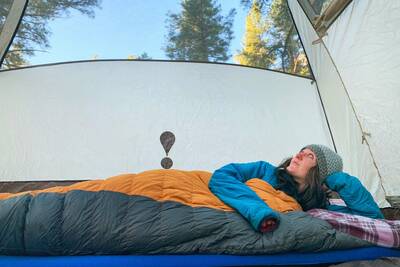
Overnight in the backcountry can be tough for side sleepers. Don’t fret, there’s help below.
That’s because sleep-focused backpacking and camping gear is by and large designed for people who lie perfectly still on their backs for the duration of the night. And if you regularly sleep on your side, maybe rolling over a few times during the night, this kind of traditional backpacking gear is woefully inadequate.
When it comes to backpacking gear, side sleepers face three main problems, each relegated to a different part of our sleep systems:
- Most sleeping bags are too fitted to allow comfortable side-sleeping.
- Many inflatable pads don’t play nicely with side sleepers.
- Most backpacking pillows are really uncomfortable for anyone who doesn’t sleep on their back.
Fear not, there are solutions out there! These backpacking tips for side sleepers will help you sleep comfortably, on your side (and even your stomach), all night long.
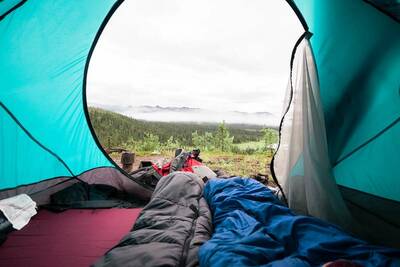
The view we’re all seeking. Get good rest to find it.
Sleeping Bags for Side Sleepers
For many backpackers, the sleeping bag is the most important part of their sleep system. But traditional mummy shaped bags, which are by far the most common on the market, don’t work well if you’re not lying flat on your back. Mummy bags have a fitted shape that narrows from your chest down to your feet, and doesn’t have room for you to bend your knees and hips, or lie in a curled, sprawling position on your side. And the hood on mummy bags have a tendency to get wrapped around your neck and head uncomfortably if you roll over during the night.
Mummy bags are so popular because the tight fit locks in warmth extremely well, and they pack down small due to less overall fabric. However, more and more gear manufacturers are coming up with sleeping bags for side sleepers with designs that make them as functional as mummy bags.
If you do sleep primarily on your side, it’s worth shopping around a little more for your sleeping bag. If you’re usually car camping, and don’t have to carry your sleeping bag anywhere in a backpack, you’re in luck because many brands make affordable rectangular sleeping bags. These aren’t as light and don’t pack down as small as more fitted mummy bags or even backpacking side sleeping bags, but they allow you a full range of motion and comfort while you’re sleeping. Some even come with adjustable “duvet” features that simulate the feeling of having an adjustable blanket that you can snug up against your chin.
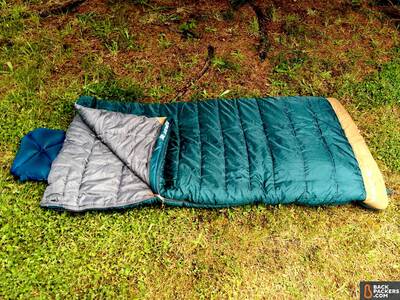
The Kelty Callisto 30 is a common rectangular sleeping bag.
However, if you’re doing longer hikes and backpacking trips, you’ll need something smaller and lighter that still allows you to sleep on your side comfortably. There are a few types of bags to look for.
First, some brands have been tweaking their mummy by making the hip and knee area a little wider. This allows your knees to splay easily. On these mummy bags they can also tweak the top hood zone to give it a bigger range of motion. These changes mean there’s more room to move around in the bag, and curl up comfortably, without getting tangled.
The Marmot Yolla Bolly bags and Sea to Summit Ascent bags are a good place to start. You can tell best by looking at the bag’s profile — if it doesn’t come in tight around the knees and feet, it’s a good start.
Then there are bags fully designed for side sleeping, like the NEMO spoon bags. These bags are much wider in the chest, hips, and feet, allowing you to side sleep and sleep on your belly with ease.
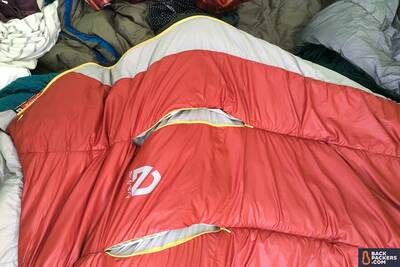
The NEMO Forte side sleeping bag allows generous knee splay.
As you’re shopping for a new bag, make sure to read the descriptions carefully and look at the profile of the bag. Brands will note when they have a side-friendly option, and list the changes they made to make it more comfortable.
Sleeping Pads for Side Sleepers
For a lot of people, just switching to a side-friendly sleeping bag will make all the difference they need. Loosening up the area around your legs for full splay does wonders. But if you’re doing multiple night trips and are looking for the ultimate comfort, or still having issues, moving to a different sleeping pad is the next best step.
When we sleep on our sides we pressure the sleeping pad in fundamentally different ways than when we lie on our backs. Our weight is more concentrated on a smaller area, and your hips, knees, and elbows end up bearing a lot of the brunt of your body weight through the night. However, figuring out how to choose a sleeping pad for side sleepers can be a little more difficult than finding the right bag, just because less brands market their pads to a specific sleep position. That said, here are a few things to look for.
For backpacking, you generally want an inflatable air pad, and you want one with more cells. Air pads usually are made up of a bunch of different air cells arranged in the shape of the pad. With bigger air cells, if you put all of your weight in one small area (like your hip) the pad has a tendency to deform and push all the air to other parts of the pad. This leaves you with a lopsided pad, and your hip resting on hard ground.
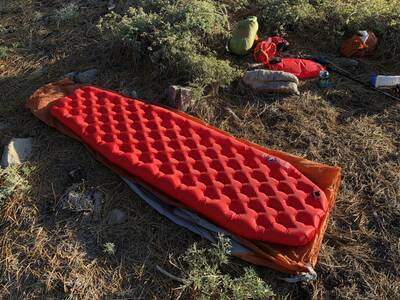
The Big Agnes AXL Air has many small, quilted cells so no single point gets pressed down easily. It also has slightly raised edges to keep you in.
However, pads with lots of smaller cells, like the Big Agnes pads or NEMO Tensor pad, resist that deformation better, and do a better job of dealing with higher loads in small areas. So look for something that’s broken up into a lot of smaller cells, rather than horizontal baffled cells. You can also purchase a rectangular pad instead of a mummy-shaped pad, and grab the wider than standard pad (25 inches instead of 20), so you have more room to actually lay on your side.
If you’re primarily car camping, or don’t care about weight, get a thick foam pad or a self-inflating foam/air hybrid pad. These have real foam inside, and don’t suffer as much from the compression issues of lightweight air pads.
Pillows for Side Sleepers
Finally, pillows. If you still can’t wrangle a comfortable night out a new pad or bag, you can take a look at pillows. Though, to be honest, if you’ve switched pad and bag you might be out of luck. Pillows are just cherries on the top of your backcountry night’s rest.
If you’re usually camping out of your car, just bring whatever pillows you usually sleep with at home. Your back and neck will thank you. However, if you’re doing longer backcountry trips, a lightweight backpacking-specific pillow makes more sense. The problem is, most backpacking pillows are designed for folks who sleep on their backs. They’re usually minimalist and designed to cradle the back of your head and the sides of your neck. That doesn’t cut it for side sleepers.
If you’re going to use an inflatable backpacking pillow, make sure it has enough volume to keep your head at a comfortable angle without slipping off, all night long. Do this by testing in the store, or keeping the receipt for returns.
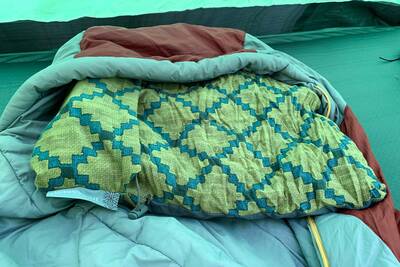
The Therm-a-Rest Compressible Pillow is made of foam, and is fairly flat. Decent for side sleeping.
We’ve found the best bets for a side sleeping backpacking pillow is a mix of inflation and foam, or just full foam. Pillows like the NEMO Fillo or Therm-a-Rest Compressible Pillow are good options. Foam especially cradles your neck in a more flexible way than an inflatable pillow, and can match the memory-foam pillow you probably have at home. Also, for most side sleepers, a flatter pillow is a better pillow.
All that said, many side-sleepers have found that there aren’t many backpacking pillow designs on the market that work well for them. Instead, take the stuff sack from your sleeping bag and fill it with the clothes you’re not wearing. This often offers more support and comfort, even if it’s a little flat.
Experiment. Try out a few different systems and figure out what works for you so that you can enjoy a relaxing night out and get a full night’s rest.
This post is Sponsored by evo
Backpackers.com Affiliate Policy: This guide contains affiliate links, which help fund our website. When you click on the links to purchase the gear we get a commission, and this goes a long way to creating guides, gear reviews, and other excellent content.
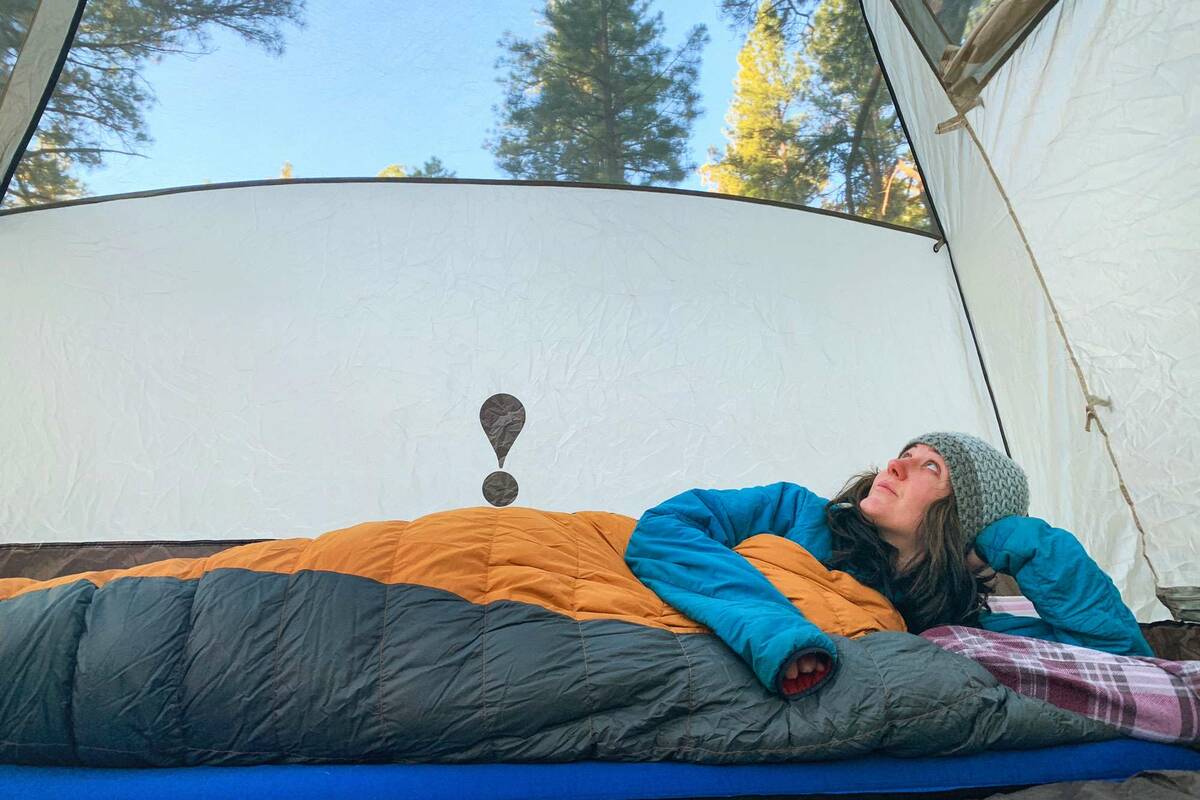

Addressing side sleepers in the backcountry without mentioning quilts seems woefully inadequate.
This is a great point John and we will look at updating a section to include quilts.
Will the luxury nemo fillo fit into the pillow compartment of my nemo riff?
Hey Mark,
Great question! We looked at the specs and don’t think it will fit 100% in the compartment. However, the compartment on the Riff is open at one end, so you can stuff it in and still have part of the pillow hanging out. Should work!
I came here to say this. A quilt and separate hood is the ideal solution for side sleeping, and equally excellent at any other position.
If I could start over as a new camper, I would start with a 30* quilt, 15* hood, and try pads, cots, and hammocks, all with tarp and groundcloth. By far the most flexible kit to try all the options and not have buyer’s remorse.
With my experience now, I am a hammock / quilt camper, and the extra comfort is well worth a very slight weight penalty compared to minimalist ground sleeping.
Thanks for the insight Jeremy!
Sponsored Slponsored
Give every company one suggested item so all your advertisers are represented—consumers beware
We state clearly that this article is sponsored by evo. We work with brand partners to provide useful information, and feel this guide does a great job!
I enjoyed the article about side sleeping. What can you suggest for the family with a new baby bundle of joy? Is there a rectangle bag that can zip together two make a double size bag?
Hi Scot,
Thanks for reading and writing in! We recommend The North Face Dolomite One Duo sleeping bag for most families with young kids 🙂 The North Face Eco Trail and Exped MegaSleep Duo are good options too!
Thanks for your helpful reviews!
I’m old enough that sleeping on the thin ultralight pads won’t work for me anymore, as I get no sleep, hurt, and then am worthless on the trail. To solve that, I have gone thick with the ExPed Downmat 9.
Yes, it is much heavier than I would prefer, but with 3” of loft, I don’t grind on the ground and get a night’s quality sleep. Because most of our heat gets lost to the ground, the pad is insulated and this allows me to use a lighter, less warm sleeping bag, which of course saves some weight. I find the remaining slight weight penalty is a small compromise for feeling really well rested, strong, and refreshed on the trail.
Thanks for reading! Totally understand going with a thicker pad. The tech has really improved, so you can get a 3″+ pad that’s fully air (like the Exped Downmat), that is still fairly light in the big scheme of things. Exped’s Downmat tech really helped push the industry forward with warm pads. Appreciate the insight and we’ll look at reviewing a similar pad!
In addition to putting clothing in the stuff sack, if you slide your pillow in there on top, you get the lift and support of the clothes, and the comfort of the pillow. I also suggest wrapping it in a fleece or other sift shirt to make it more comfy.